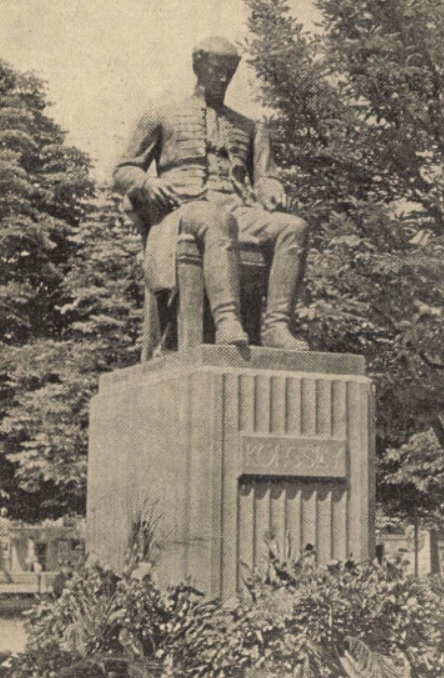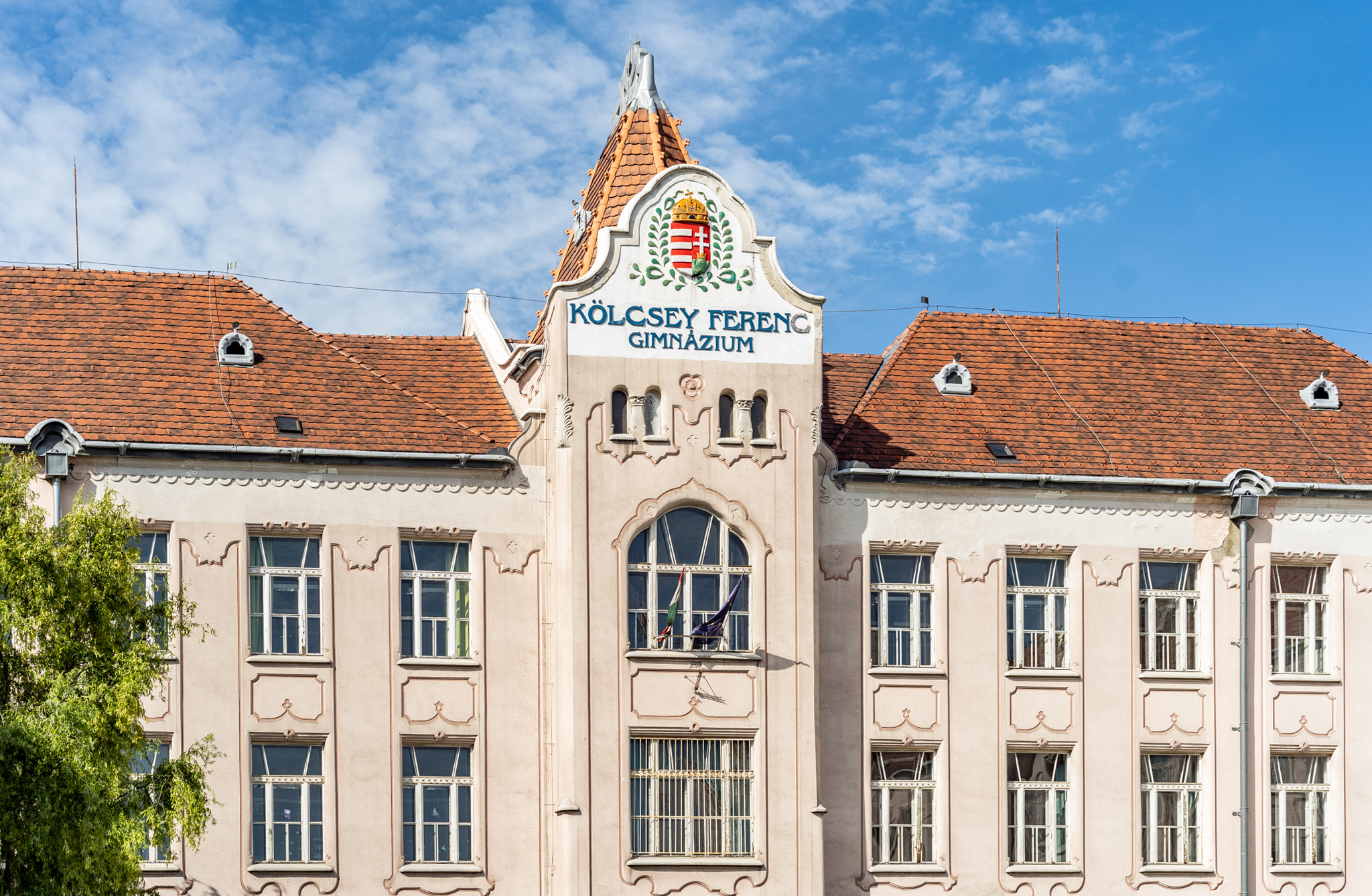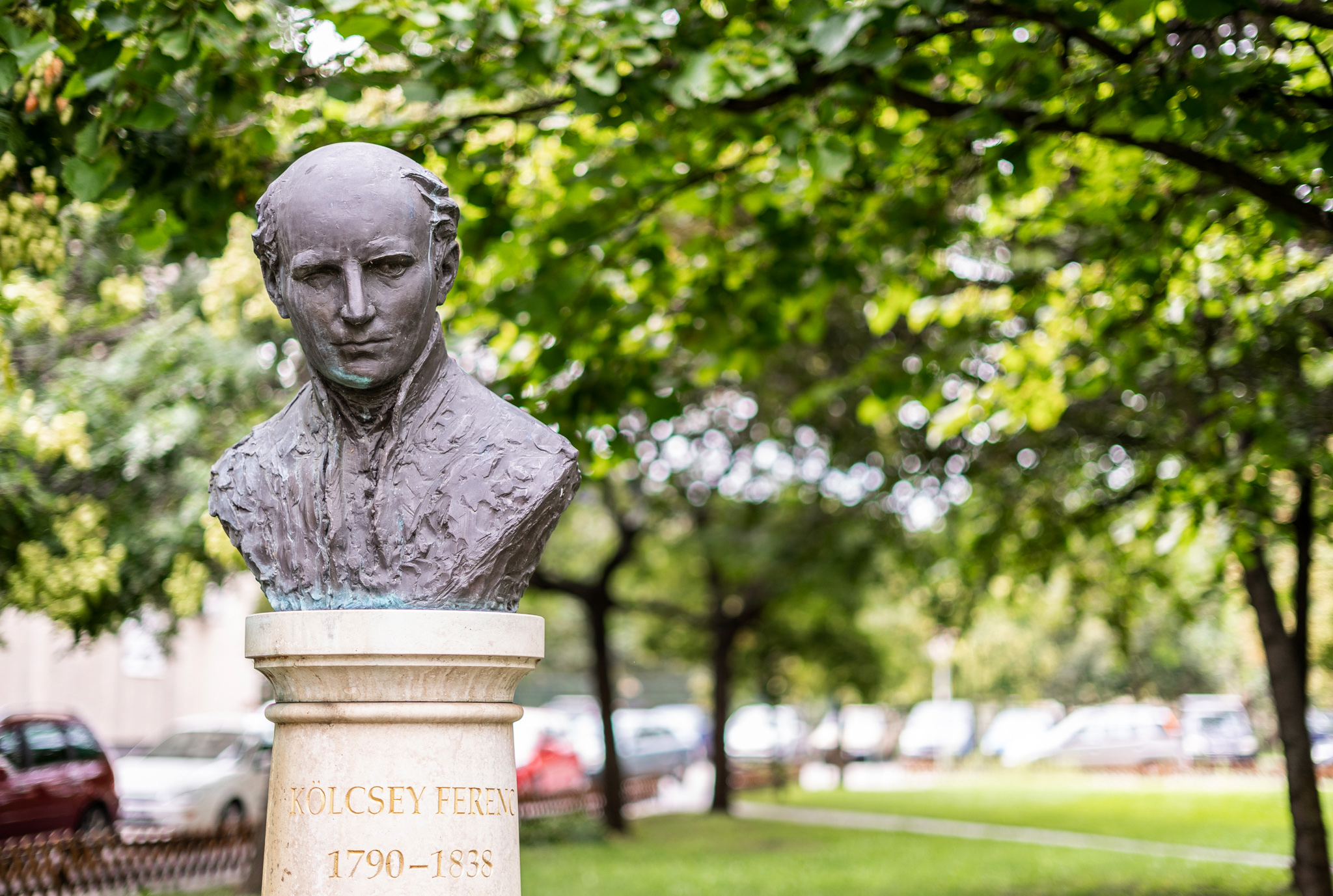Ferenc Kölcsey was born on 8 August 1790 in Sződemeter, Szatmár County, and died on 24 August 1838, in Szatmárcsek, in the same county. He was one of the most famous personalities of the Reform period, yet, his name was emblazoned most of all by his poem Himnusz. On the 100th anniversary of his death, the periodical Koszorú wrote the following on Kölcsey: "In the memory of the Hungarian nation, Kölcsey lives as the poet of our national anthem. His memory is preserved in this one poem, which nevertheless elevates him among the greatest heroes of the Hungarian spirit. If there is immortality in earthly life, Kölcsey is immortal, and so is the Himnusz. And deservedly is it so. Inspired in a lucky hour, this poem won eternal life the moment it was born.”

The original manuscript of the Himnusz (Source: National Public Education Portal https://www.nkp.hu/)
However, despite his great popularity, the people of Budapest had to wait until 1939 to have a significant public sculpture of Kölcsey erected in Batthyány Square. However, fewer people know that a statue of Kölcsey was made in Budapest as early as 1845, but since it was only visible in the National Museum for a long time, the work on Batthyány Square was actually the first real Kölcsey statue erected in Budapest.

The statue of Ferenc Kölcsey was erected in Batthyány Square (Source: Uj Idők, 2 July 1939, photo by Jenő Dulovits)
The original work stood in Nagykároly from 1897, but after World War I, the Romanian troops occupying the city destroyed the statue. A surviving plaster sample allowed the copy to be restored in Budapest. However, as the work was not completed by the centenary of Kölcsey's death (1838), it was not inaugurated in the middle of Batthyány Square until 1939. Kölcsey's statue on a high pedestal faced the Parliament at the time and stood roughly where the metro exit building is now.
%20K%C3%A9pes%20Vas%C3%A1rnap%2C%201940.%20december%2015..jpg)
A wreath was lain on the memorial statue of Ferenc Kölcsey on the occasion of the Kölcsey Memorial Days in 1940 (Source: Képes Vasárnap, 15 December 1940, photo by Béla Szász)

Until the 1950s, the Kölcsey statue stood here in the middle of the square and was then moved due to the planned metro construction (Photo: Fortepan / No.: 4307)
Ede Kallós' work was then moved in 1950, due to, as claimed, the construction of the metro. It returned much later in 1974, but not to the centre of the square, but to the edge of the square, deprived of its old central splendour and high pedestal. Behind the statue, a wall was erected on which the lines of the poem Huszt can be read.

The statue of Ferenc Kölcsey no longer looks at the Parliament but sits on the edge of the square (Photo: Balázs Both/pestbuda.hu)

Kölcsey's statue, having lost its high pedestal, the gaze of the statue does not meet the gaze of the people looking up at it, but seems to look down on the ground sadly (Photo: Both Balázs / pestbuda.hu)
However, it is an interesting fact that this was not the first Kölcsey sculpture to be seen in Budapest, but the work of the famous sculptor István Ferenczy, which was completed in 1845. However, the 1939 statue is considered to be the first Kölcsey statue in Budapest. The most obvious explanation for this is that the statue of Ferenczy never stood in the open air and thus was not solemnly unveiled.

István Ferenczy's drawing of the Kölcsey statue in 1846 (Pesti Divatlap, 1 August 1846)
After the death of Ferenc Kölcsey in the summer, the Kisfaludy Society initiated the erection of a memorial statue in Budapest in the autumn, the costs of which were soon collected from public donations and by 1845, Ferenczy had already completed one of the largest works of his life. The statue was intended for the garden of the National Museum but was eventually erected inside the museum building and stood in several places.
It is not known exactly why it was not inaugurated outdoors, but perhaps the reason may have been that the public was divided by the antique, toga-clad marble statue of Kölcsey. The newspaper Koszorú wrote: “A seated position in public sculptures is a sign of superiority – of stature above others or of a quiet office academic. This is how […] the poorly designed and primitive Kölcsey statue by Ferenczy is formed in our Pest museum.”
Of course, there were those who liked the sculpture, but most newspapers attacked the work for not depicting Kölcsey in Hungarian clothes. The work is currently in the Hungarian National Gallery. The seated position and the huge marble pedestal were probably borrowed from this work later by Ede Kallós to the Kölcsey statue in Nagykároly in 1897, which, learning from the mistakes of others, he modelled in Hungarian clothes.

The sitting statue of Kölcsey, made by István Ferenczy in 1845, is currently on display in the National Gallery (Source: Hungarian National Gallery)

The statue of Ferenc Kölcsey nowadays on the edge of Batthyány Square (Photo: Balázs Both/pestbuda.hu)
A commemorative plaque for the centenary of the poet's death in 1938 was also made, Fülöp Ö. Beck's work had an adventurous history. The plaque was removed from the wall after questionable parts of the artist's personal life came to light. . However, he managed to save his work, and finally, in 1955, another shorter memorial plaque was placed on Kölcsey Street in the 8th District.

The memorial plaque to Ferenc Kölcsey was finally erected on the wall of the house at 1 Kölcsey Street in 1955 (Photo: Balázs Both/pestbuda.hu)
The large memorial plaque with its adventurous fate was erected in a courtyard of the former Pest County building, at 7 Városháza Street in the 5th district, slightly hidden and devoid of any splendour. The marble plaque below the relief reads: “In this courtyard of the manor house of Pest County, the poet of the Himnusz, FERENC KÖLCSEY, chief notary and Member of Parliament for Szatmár Country often spent time with his friends. On the 100th anniversary of his death, 24 August 1938the “István Gyöngyösi Society” of the writers of the counties ignited the vigilant and awakening patriotic flame here before his ever-illuminating spirit.”

The memorial plaque made for the 100th anniversary of Kölcsey's death did not appear for a long time, but can now be seen in the courtyard of the former Pest County building (Photo: Balázs Both/pestbuda.hu)
Until the fall of socialism, no new plaque, relief or any major public monument was created to honour Kölcsey. Schools, grammar schools and various institutions, which took the name of Ferenc Kölcsey, began to re-cultivate the memory of Kölcsey with various plaques, statues and reliefs. The first such memorial was made by Pál Kő in 1991, the statue of Ferenc Kölcsey is located in the hall of Kölcsey High School in the 6th District.
 Kölcsey Ferenc Grammar School took the name of the author of the poet in 1921 (Photo: Balázs Both/pestbuda.hu)
Kölcsey Ferenc Grammar School took the name of the author of the poet in 1921 (Photo: Balázs Both/pestbuda.hu)

The full-sized Kölcsey statue by Pál Kő in the hall of the grammar school (Photo: Balázs Both/pestbuda.hu)

Kölcsey has a sword on his side, a wreath on his head, his Hungarian clothes evoke his time and the poet himself. Below the text of his epigram entitled Huszt can be read on the statue (Photo: Balázs Both/pestbuda.hu)
In Rákosszentmihály, under 1 Hősök Square, two reliefs were created on both sides of the entrance of the Ferenc Kölcsey Primary School in 1998, with a donation from Mária R. Törley. The Kölcsey relief reads: "Every career is glorious if it sheds light on your homeland."
 Entrance to the Kölcsey Ferenc Primary School in Rákosentmihály, with the reliefs on both sides (Photo: Balázs Both/pestbuda.hu)
Entrance to the Kölcsey Ferenc Primary School in Rákosentmihály, with the reliefs on both sides (Photo: Balázs Both/pestbuda.hu)

The relief on the right depicts Ferenc Kölcsey (Photo: Balázs Both/pestbuda.hu)

The sculpture on the left shows the name, address of the school and the Hungarian coat of arms (Photo: Balázs Both/pestbuda.hu)
The Kölcsey Ferenc Primary School also erected several memorials to the poet in Csepel, where a relief plaque was first erected on the school wall in 2003 – a work by Péter Kaubek – on which Kölcsey's portrait and a famous quote are cited. Then in 2008, Gabriella Kőszeghy made a bronze bust of Kölcsey, which can be seen in the school hall.

This Kölcsey memorial plaque can be seen on the wall of the Kölcsey Ferenc Primary School in Csepel (Photo: Balázs Both/pestbuda.hu)
Currently, the only outdoor sculpture that can be seen outside the Batthyány Square is the Kölcsey bust made by Márk Lelkes, which has been standing in Pesterzsébet, at 23 Topánka Street, since 2006.

Apart from the statue in Batthyány Square, this is the only Kölcsey statue that can be found outdoors (Photo: Balázs Both/pestbuda.hu)

The Kölcsey bust can be found at 23 Topánka Street in the 20th District (Photo: Balázs Both/pestbuda.hu)
Thus, several Kölcsey statues and monuments have been made recently, but if the work on Batthyány Square were to regain its central role and a pedestal of its original height, Budapest would certainly preserve the memory of Ferenc Kölcsey in a more dignified way.
Cover photo: Statue of Ferenc Kölcsey on Batthyány Square (Photo: Balázs Both/pestbuda.hu)





































Hozzászólások
Log in or register to comment!
Login Registration